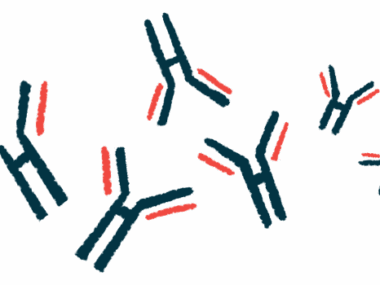3 Cases of Cancer-associated NMOSD Reported in Case Series
AQP4 protein's presence on cancer cells why NMOSD can accompany cancer
Written by |

Tumor removal and immunosuppressive treatment can resolve neuromyelitis optica spectrum disorder (NMOSD) likely associated with different types of cancer positive for aquaporin 4 (AQP4) protein, according to data from three cases in China.
Only two patients showed consistently high blood levels of antibodies against AQP4 (AQP4-IgG) — the most common NMOSD-causing antibody — suggesting that other abnormal antibodies could have driven the autoimmune disease in the third patient.
Together, these cases add to the rare reports of NMOSD triggered by tumors, particularly those positive for AQP4, the researchers noted.
The cases were detailed in “Neuromyelitis optica spectrum disorders associated with AQP4-positive-cancer — A case series,” published in Frontiers in Neurology.
NMOSD is caused by an erroneous attack from the immune system to healthy tissue in the brain and spinal cord. This may lead to damaging inflammation in the spinal cord (transverse myelitis) and the optic nerve (optic neuritis), which carries messages from the eye to the brain.
Antibodies against AQP4, a protein at the surface of neuron-supporting brain cells called astrocytes, are seen in about 80% of NMOSD patients, making testing for the presence of these antibodies critical for its diagnosis. Diagnostic criteria “are more stringent and require critical clinical criteria and additional neuroimaging findings” in those without such antibodies, the researchers wrote.
While NMOSD typically occurs spontaneously, it’s been associated with different types of cancer in rare cases since AQP4 is also on the surface of some cancer cells and is associated with tumor growth. As such, the antibodies produced by the immune system to fight cancer may also affect astrocytes in the brain.
Autoimmune diseases such as NMOSD that can be triggered by an immune response against cancer are called paraneoplastic neurological syndromes.
Three cases of NMOSD with cancer
A research team in China described the cases of three adults with NMOSD likely associated with different cancer types, whose tumor sections revealed high AQP4 levels.
The first patient was a 30-year-old woman who had a temporary loss of consciousness, blurred vision, hearing loss, and slurring speech. She had recurrent abdominal pain, nausea, and vomiting for three years.
The woman had a history of teratoma, a rare type of tumor that typically forms in the ovary and can generate different types of tissues, such as hair, teeth, muscle, and bone. The cancer was found and removed in her left ovary and later diagnosed in the right ovary, but not treated.
Testing allowed the diagnosis of NMOSD — even with a negative result for AQP4-IgG in her blood — due to two core clinical features. These included optic neuritis and persistent episodes of nausea, vomiting, and hiccups. These are collectively referred to as area postrema syndrome in the context of NMOSD.
Her symptoms were reduced with treatment, and at some point, her AQP4-IgG levels were found to be slightly higher than normal, but weren’t detected after that.
A nodule in her right lung was then seen, which tumor tissue analysis after its removal showed to be an adenocarcinoma, the most common type of lung cancer, that showed high levels of AQP4.
“To our knowledge, Case 1 is the first paraneoplastic NMOSD case associated with both recurrent teratoma and lung adenocarcinoma,” the researchers wrote.
The second patient, a 39-year-old woman, complained of numbness of her lower limbs, painful or uncomfortable urination, and difficulty defecating in the past three weeks. She tested positive for AQP4-IgG in her blood and had transverse myelitis, meeting NMOSD diagnostic criteria.
An abdominal CT allowed the subsequent detection of an AQP4-positive teratoma in her right ovary, which was surgically removed. She completely recovered with appropriate anti-inflammatory and immunosuppressive treatment, although she was still positive for AQP4-IgG.
The third patient was a 25-year-old man who had reduced vision in both eyes for two months. Further examination showed he had optic neuritis, transverse myelitis, and was positive for AQP4-IgG in the blood, confirming a NMOSD diagnosis.
His symptoms worsened despite appropriate treatment and he was found to have a tubulovillous adenoma — a type of polyp — in the colon that was positive for AQP4-IgG. The tumor was removed and he received anti-cancer therapy. Two months later, his AQP4-IgG levels were significantly reduced and his condition was stable.
“After tumor removal, all cases were stable and suffered no further relapses, which revealed the potential paraneoplastic mechanism between cancer and NMOSD,” the researchers wrote, adding the absence of consistently high levels of AQP4-IgG in the first patient “may be attributed to the fact that the concentration of AQP4-IgG [was] too low to be detected by the present method.” Another reason could be that AQP4-IgG was not the primary disease-causing antibody in this case and that other antibodies triggered NMOSD. Antibodies against the protein MOG, which account for about 42% of all AQP4-IgG-negative cases, were not detected either.
“The cross-talking between NMOSD and cancer remains a mystery and is worth further in-depth research,” the researchers wrote.






